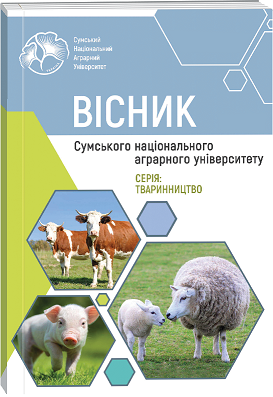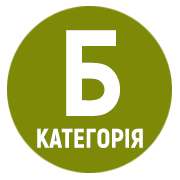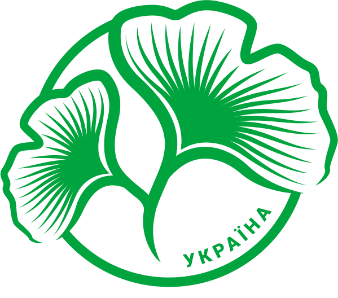ЗАЛЕЖНІСТЬ ЯКОСТІ ТУШ КНУРІВ ТА ЕКОНОМІЧНОЇ ЕФЕКТИВНОСТІ ВИРОБНИЦТВА СВИНИНИ ВІД ЇХ ПЕРЕДЗАБІЙНОЇ ЖИВОЇ МАСИ ЗА РІЗНИХ СПОСОБІВ ЇХ КАСТРАЦІЇ
Анотація
В статті вивчались залежність якості туш кнурів за різної передзабійної маси та способу кастрації і економічну ефективність їх вирощування та забою. Для цього 200 кнурців, отриманих від свиноматок F1 (♀ВБ × ♂Л) та термінальних кнурів сентитичної лінії РІС-337 англійського походження були розділені на дві групи, 100 з яких піддали хірургічній кастрації на другий день їх життя, тоді як інші 100 залишилися некастрованими до застосування імунокастрації, яка проводилася вакциною «Імпровак» у віці 112 та 140 діб. Під час дорощування та відгодівлі тварин утримували у стандартних промислових умовах у групових станках по 50 голів, із повністю щілинною підлогою та автоматизованою системою годівлі, яка здійснювалася 10–14 разів на добу рідкими кормовими сумішами у співвідношенні сухої та рідкої фракцій 1:2,7–3,0. За досягнення піддослідними тваринами середньої живої маси 110 кг, їх індивідуально зважували, та розподіляли як хірургічних так і імунологічних кастратів на три групи з передзабійною живою масою – 100, 110 та 120 кг з иподальшим забоєм на ТОВ «Глобинський мясокомбінат» з визначенням морфологічного складу туш та великокускових напівфабрикатів. Встановлено, що імунокастровані тварини мали вищий відсоток пісного м’яса у туші та знижену частку жирової тканини, що може бути вигідним для виробників м’яса, які орієнтуються на ринок пісної свинини. Доведено, що найвищу економічну ефективність при відгодівлі та забої кнурів досягнуто за передзабійної живої маси 120 кг, незалежно від способу кастрації, а загальний прибуток від імуно-кастрованих тварин виявився вищим через менші витрату кормів та оптимальні показники виходу м’яса, що спричинило вищий прибуток від його реалізації. Встановлено що у плечолопатковій частині туші хірургічно кастровані свині демонстрували вищу вагу та частку кісток з шиї та шпику із шкірою, відносно імунокастрованих аналогів, але поступались останнім за вагою та часткою свинини односортної з шиї, свинини односортної з лопатки та кісток лопатки. У спинно-поперековій частині туші кнурці за обох способів кастрації відрізнялись лише більшою вагою та вмістом кісток балика та грудинки у імунокастрованих самців відносно хірургічно-кастрованих однолітків. Доведено переважання ваги та вмісту більшості м’ясних відрубів у трьох частинах туші 120 кг кнурців відносно більш легких 100 та 110 кг аналогів за обох способів кастрації. Встановленоо що при забої з живою масою 100 кг імунокастрація забезпечила на 140 грн більше прибутку порівняно з хірургічною кастрацією. Визначено, що найбільш доцільним точки зору доходу від реалізації великокускових напівфабрикатів є забій за живої маси 120 кг, незалежно від методу кастрації. Визначено, що середні показники доходу були вищими у імунокастрованих кнурців, що вказує на їхню потенційну економічну перевагу в умовах промислового свинарства. Використання імунокастрації забезпечує підвищення рентабельності виробництва, особливо у випадку збуту пісної свинини. Необхідно проводити подальші дослідження щодо впливу методу кастрації на довготривале збереження якості м’яса та споживчі властивості продукції.
Посилання
2. Andrieieva, D., Povod, M. (2020). Vplyv imunnoi kastratsii svynei na yikh zabiini ta miasni yakosti pry riznii peredzabiinii zhyvii masi [Influence of immune castration of pigs on their slaughter and meat qualities at different pre-slaughter live weight]. Bulletin of Sumy National Agrarian University. The Series: Livestock, 4(43), 20–26. https://doi.org/10.32845/bsnau.lvst.2020.4.3. (in Ukrainian)
3. Backus, G., Støier, S., Courat, M., Bonneau, M., Higuera, M. (2014). First progress report from the European declaration on alternatives to surgical castration of pigs. Retrieved from http://www.gruppoveterinariosuinicolomantovano.it/documenti/first_progress_report_from_the_european.pdf (Accessed on 14.09.2024).
4. Batorek, N., Čandek-Potokar, M., Bonneau, M., Van Milgen, J. (2012a). Meta-analysis of the effect of immunocastration on production performance, reproductive organs and boar taint compounds in pigs. Animal, 6(8), 1330–1338. https://doi.org/10.1017/S1751731112000146.
5. Batorek, N., Škrlep, M., Prunier, A., Louveau, I., Noblet, J., Bonneau, M., Čandek-Potokar, M. (2012b). Effect of feed restriction on hormones, performance, carcass traits, and meat quality in immunocastrated pigs. Journal of Animal Science, 90, 4593–4603. https://doi.org/10.2527/jas.2012-5330.
6. Batorek-Lukač, N., Kress, K., Čandek-Potokar, M., Fazarinc, G., Škrlep, M., Poklukar, K., Wesoly, R., Stefanski, V., Vrecl, M. (2022). Immunocastration in adult boars as a model for late-onset hypogonadism. Andrology, 26. https://doi.org/10.1111/andr.13219.
7. Bee, G., Quiniou, N., Maribo, H., Zamaratskaia, G., Lawlor, P.G. (2020). Strategies to meet nutritional requirements and reduce boar taint in meat from entire male pigs and immunocastrates. Animals, 10, 1950. https://doi.org/10.3390/ani10111950.
8. Boler, D.D., Puls, C.L., Clark, D.L., Ellis, M., Schroeder, A.L., Matzat, P.D., Killefer, J., McKeith, F.K., Dilger, A.C. (2014). Effects of immunological castration (Improvest) on changes in dressing percentage and carcass characteristics of finishing pigs. Journal of Animal Science, 92(1), 359–368. https://doi.org/10.2527/jas.2013-6863.
9. Bonneau, M., Weiler, U. (2019). Pros and cons of alternatives to piglet castration: Welfare, boar taint, and other meat quality traits. Animals, 9(11), 884. https://doi.org/10.3390/ani9110884.
10. Borell, E., Bonneau, M., Holinger, M., Prunier, A., Stefanski, V., Zöls, S., Weiler, U. (2020). Welfare aspects of raising entire male pigs and immunocastrates. Animals, 10(11), 2140. https://doi.org/10.3390/ani10112140.
11. Brewster, V., Nevel, A. (2013). Immunocastration with Improvac™ reduces aggressive and sexual behaviours in male pigs. Applied Animal Behaviour Science, 145(1–2), 32–36. https://doi.org/10.1016/j.applanim.2013.01.012.
12. Daza, A., Latorre, M. A., Olivares, A., López-Bote, C. J. (2014). The effect of immunocastration and a diet based on granulated barley on growth performance and carcass, meat and fat quality in heavy gilts. Animal, 8(3), 484–493. https://doi.org/10.1017/S1751731113002292.
13. Driessen, B., Van Beirendonck, S., Buyse, J. (2020). Effects of housing, short distance transport and lairage on meat quality of finisher pigs. Animals, 10(5), 788. https://doi.org/10.3390/ani10050788.
14. EFSA. (2004). Welfare aspects of the castration of piglets. Scientific Report of the Scientific Panel for Animal Health and Welfare on a request from the Commission related to welfare aspects of the castration of piglets European Food Safety Authority 2004 AHAW/04-087. [Elektronnyi resurs]. Rezhym dostupu: https://efsa.onlinelibrary.wiley.com/doi/epdf/10.2903/j.efsa.2004.91. (data zvernennia 09.03.2025)
15. European Commission. (2010). European declaration on alternatives to surgical castration of pigs. [Elektronnyi resurs]. – Rezhym dostupu: https://food.ec.europa.eu/system/files/2016-10/aw_prac_farm_pigs_cast-alt_declaration_en.pdf. (data zvernennia 09.03.2025)
16. Font-i-Furnols, M., Gispert, M. (2019). Comparison of meat quality characteristics and boar taint prevalence in pigs with different production systems. Meat Science, 156, 108–116. https://doi.org/10.1016/j.meatsci.2019.05.007.
17. Font-i-Furnols, M., Tous, N., Esteve-Garcia, E., Gispert, M. (2012). Do all consumers accept the same risk of boar taint? Meat Science, 92(2), 180–187. https://doi.org/10.1016/j.meatsci.2012.04.005.
18. Fredriksen, B., Johnsen, A. M. S., Skuterud, E. (2011). Consumer attitudes towards castration of piglets and alternatives to surgical castration. Research in Veterinary Science, 90(2), 352–357. https://doi.org/10.1016/j.rvsc.2010.06.018.
19. Gispert, M., Oliver, M. A., Pérez, J., Suarez, P., Juez, J. (2010). Influence of castration method on carcass characteristics in pigs. Livestock Science, 132(1–3), 155–159. https://doi.org/10.1016/j.livsci.2010.05.012.
20. Gispert, M., Oliver, M. A., Velarde, A., Suarez, P., Pérez, J., Font-i-Furnols, M., Diestre, A., Juez, J. (2012). Effect of transport and lairage time on meat quality in pigs. Meat Science, 90(3), 690–696. https://doi.org/10.1016/j.meatsci.2011.10.002.
21. Huber, L., Squires, E., Mandell, I., De Lange, C. (2018). Age at castration (surgical or immunological) impacts carcass characteristics and meat quality of male pigs. Animal, 12(3), 648–656. https://doi.org/10.1017/S1751731117002063.
22. ISO 23781:2021. Operating procedures of pig slaughtering. International Organization for Standardization, Geneva, Switzerland. [Elektronnyi resurs]. Rezhym dostupu: https://standards.iteh.ai/catalog/standards/iso/300396ea-2102-4999-897f-c2f5315f3a31/iso-fdis-23781. (data zvernennia 09.03.2025)
23. ISO 3100-1. Meat and meat products – Sampling and preparation of test samples – Part 1: Sampling. International Organization for Standardization, Geneva, Switzerland. [Elektronnyi resurs]. – Rezhym dostupu: https://standards.iteh.ai/catalog/standards/iso/173c37dd-6a81-4146-beeb-bb1c6fe94c52/iso-3100-1-1991 (data zvernennia 09.03.2025)
24. Jaros, P., Bürgi, E., Stärk, K. D. C., Claus, R., Hennessy, D., Thun, R. (2005). Effect of immunization against GnRH on androstenone concentration, growth performance and carcass quality in intact male pigs. Livestock Production Science, 92, 31–38. https://doi.org/10.1016/j.livprodsci.2004.07.011.
25. Lucas, D. S., Siqueira, E. T. F., Haguiwara, M. M. H., Azevedo, S. S., Yotsuyanagi, S. E., Silva, T. J. P., Soto, F. R. M. (2016). Effect of piglet castration with nonsurgical sterilant on the zootechnical performance and pork carcass quality. Arquivo Brasileiro de Medicina Veterinária e Zootecnia, 68(6). https://doi.org/10.1590/1678-4162-9154.
26. Mancini, M. C., Menozzi, D., Arfini, F. (2017). Immunocastration: Economic implications for the pork supply chain and consumer perception. An assessment of existing research. Livestock Science, 203, 10–20. https://doi.org/10.1016/j.livsci.2017.06.012.
27. Mykhalko, O., Povod, M., Sokolenko, V., Verbelchuk, S., Shuplyk, V., Shcherbatiuk, N., Melnyk, V., Zasukha, L. (2022). The influence of the castration method on meat cuts indicators of pig carcasses. Scientific Papers. Series Management, Economic Engineering in Agriculture and Rural Development, 22(3), 451–458. https://managementjournal.usamv.ro/pdf/vol.22_3/Art48.pdf.
28. Mykhalko, O. G. (2020). Vidhodivelni yakosti svynei irlandskoho pokhodzhennia za riznykh typiv hodivli [Feeding qualities of pigs of Irish origin under different types of feeding]. Bulletin of the Sumy National Agrarian University. Livestock Series, 4, 51–57 (in Ukrainian). https://doi.org/10.32845/bsnau.lvst.2020.3.9.
29. Mykhalko, O. G. (2021). Zalezhnist vidhodivelnykh yakostei svynei datskoho pokhodzhennia vid typu hodivli [Dependence of fattening qualities of pigs of Danish origin on the type of feeding]. Bulletin of the Sumy National Agrarian University. Livestock Series, 4, 99–108 (in Ukrainian). https://doi.org/10.32845/bsnau.lvst.2021.4.17.
30. Nikbin, S., Panandam, J. M., Sazili, A. Q. (2016). Influence of pre-slaughter transportation and stocking density on carcass and meat quality characteristics of Boer goats. Italian Journal of Animal Science, 15(3), 504–511. https://doi.org/ 10.1080/1828051X.2016.1217752.
31. Pauly, C., Spring, P., O’Doherty, J. V., Ampuero Kragten, S., Bee, G. (2009). Growth performance, carcass characteristics and meat quality of group-housed boars subjected to different levels of immunocastration. Animal, 3(8), 1282–1291. https://doi.org/10.1017/S1751731109004735.
32. Pinto, P. R., Martin, L., Ramos, A., Conceição, M., da Costa, R., Vaz-Velho, M. (2022). Feeding and housing boars after puberty without castration allows for good performance and low boar taint. Journal of Animal and Feed Sciences, 31(2), 123–134. https://doi.org/10.22358/jafs/148234/2022.
33. Poklukar, K., Čandek-Potokar, M., Vrecl, M., Batorek-Lukač, N., Fazarinc, G., Kress, K., Weiler, U., Stefanski, V., Škrlep, M. (2021). The effect of immunocastration on adipose tissue deposition and composition in pigs. Animal, 15(2), 100118. https://doi.org/10.1016/j.animal.2020.100118.
34. Povod, M., Mykhalko, O., Gutyj, B., Borshchenko, V., Verbelchuk, T., Lavryniuk, O., Shostia, H., Shpyrna, I. (2024). Growth intensity and feeding efficiency of surgically and immunologically castrated male pigs on a liquid type of feeding. Scientific Papers. Series Management, Economic Engineering in Agriculture and Rural Development, 24(1), 799–810. https://managementjournal.usamv.ro/pdf/vol.24_1/volume_24_1_2024.pdf.
35. Povod, M., Mykhalko, O., Kyselov, O., Opara, V., Andreychuk, V., Samokhina, Y. (2021). Effects of various preslaughter weights on the physico-chemical qualities of pig meat. Journal of Advanced Veterinary and Animal Research, 8(3), 521–533. https://doi.org/10.5455/javar.2021.h542.
36. Povod, M. G., Bankovska, I. B., Shpetnyi, M. B., Mykhalko, O. H. (2020). Particularity of sensory evaluation of “boar taint” in the pork by consumers. Scientific Papers. Series Management, Economic Engineering in Agriculture and Rural Development, 20(2), 389–395. https://managementjournal.usamv.ro/pdf/vol.20_2/volume_20_2_2020.pdf. Accessed on 14.09.2024.
37. Povod, M. G., Mykhalko, O. G., Shpetniy, M. B., Zhizhka, S. V., Klindukhova, I. M., Nechmilov, V. M. (2018). Morfolohichnyi sklad tush svynei pry riznykh sposobakh kastratsii [Morphological composition of pig carcasses by different methods of castration]. Scientific and Technical Bulletin IT NAAS, 119, 114–122 (in Ukrainian). http://irbis-nbuv.gov.ua/cgi-bin/irbis_nbuv/cgiirbis_64.exe?C21COM=2 I21DBN=UJRN P21DBN=UJRN IMAGE_FILE_DOWNLOAD=1 Image_file_name=PDF/Ntb_2018_119_17.pdf. Accessed on 11.07.2022.
38. Prunier, A., Bonneau, M., Borell, E. H., Cinotti, S., Gunn, M., Fredriksen, B., Giersing, M., Morton, D., Tuyttens, F., Velarde, A. (2006). A review of the welfare consequences of surgical castration in piglets and the evaluation of non-surgical methods. Animal Welfare, 15, 277–289. https://www.researchgate.net/publication/262862125_A_review_of_the_welfare_consequences_of_surgical_castration_in_piglets_and_the_evaluation_of_non-surgical_methods. Accessed on 11.07.2022.
39. Prunier, A., Mounier, A. M., Hay, M. (2005). Effects of castration, tooth resection, or tail docking on plasma metabolites and stress hormones in young pigs. Journal of Animal Science, 83, 216–222. https://doi.org/10.2527/2005.831216x.
40. von Borell, E., Baumgartner, J., Giersing, M., Jäggin, N., Prunier, A., Tuyttens, F., Edwards, S. A. (2009). Animal welfare implications of surgical castration and its alternatives in pigs. Animal, 3(11), 1488–1496. https://doi.org/10.1017/S175173110900467X.
41. Weiler, U., Font i Furnols, M., Fischer, K., Kemmer, H., Oliver, M. A., Gispert, M., Dobrowolski, A., Claus, R. (2006). Influence of different boar taint compounds on odor perception. Meat Science, 72(2), 309–315. https://doi.org/10.1016/j.meatsci.2005.07.011.
42. Zamaratskaia, G., Rasmussen, M. K. (2015). Immunocastration of male pigs – situation today. Procedia Food Science, 5, 324–327. https://doi.org/10.1016/j.profoo.2015.09.064.
43. Zoels, S., Reiter, S., Ritzmann, M., Weiß, C., Numberger, J., Schütz, A., Lindner, P., Stefanski, V., Weiler, U. (2020). Influences of immunocastration on endocrine parameters, growth performance and carcass quality, as well as on boar taint and penile injuries. Animals, 10(2), 346. https://doi.org/10.3390/ani10020346

 ISSN
ISSN  ISSN
ISSN 



